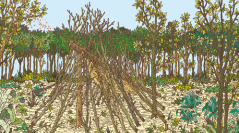

 Anthropozoologica
57 (10) - Pages 223-239
Anthropozoologica
57 (10) - Pages 223-239The study focuses on a form of managing and harvesting honey from migrating swarms of the giant Asian honey bee (Apis dorsata Fabricius, 1793). Closer to bee maintaining or bee tending than to beekeeping, the “rafter” technique consists of positioning, on the ground or in branches, a slightly inclined hardwood plank or a section of tree trunk under which the bees establish a colony by building their single-comb nest. The man-made structure (imitating a tree branch) facilitates the nesting of bees and has the advantage of being more accessible to harvesters than the tall trees or rock cliffs where colonies are generally encountered. The article shows how, in anticipation of the arrival (or the return) of migrating swarms, the harvesters of Belitung Island in Indonesia seek out and prepare a habitat that they consider to be suited to the behavior of the bees. It demonstrates that rafter harvesters have an extensive emic understanding of their environment and of the honey bees’ interactions with vegetation. In Belitung, local knowledge of the bees’ habitat and the rafter technique is not limited only to knowledge about the type of physical support that is appropriate, but also includes knowledge about how and where it should be placed: the position of a rafter is adjusted at each location to form a shelter that can be compared to a “niche” (in the Gibsonian sense). Belitung harvesters also stress the important role of sunlight in attracting the bees, an explanation also shared by scientists. We hypothesize here that their focus is not on the bees or the swarm as a sentient organism but on their own understanding of the environment’s properties.
Apis dorsata, rafter beekeeping, pollination, traditional ecological knowledge, affordance, sensory perception